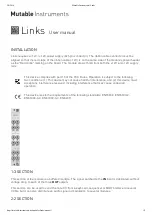
CHAPTER 3: SYSTEM ARCHITECTURE
SNAP PAC Brains User’s Guide
15
15
available resources for learning about building and maintaining such a network. We strongly
suggest you learn as much as possible about the subject and plan your network carefully before
beginning, in order to get the best performance from your system.
Because SNAP PAC brains have two switched Ethernet network interfaces, you can install them in a
daisy-chain configuration. See the next section for more information.
Using SNAP PAC Brain Network Interfaces
As illustrated conceptually at right, SNAP PAC brains
have two Ethernet network interfaces. Ethernet 1 and
Ethernet 2 are not redundant interfaces; they are
connected by an unmanaged switch.
Ethernet devices are normally networked in a standard
star configuration. If you are using this standard
configuration, connect either Ethernet 1 or Ethernet 2 to
the network. The two interfaces share the same IP
address, and either one will send a BootP request.
As an option, however, the SNAP PAC brain’s two
switched Ethernet interfaces let you use a daisy-chain
configuration for distributed I/O, connecting just one
brain to the network and then connecting subsequent
brains in a chain.
The primary advantage of daisy-chaining is that you save the expense of network routers or switches.
The primary disadvantage is similar to that of a serial network: if communication with one brain is lost,
communication to all brains beyond it on the daisy chain will also be lost.
IMPORTANT:
If you choose a daisy-chain configuration, make certain that the brains are connected
correctly. Incorrect connections can produce major problems on the network. Make sure that daisy-chain
connections are made in a simple open-ended chain, as shown in the diagram on the following page.
Unmanaged switch
Brain
Unmanaged switch
Ethernet 1
Ethernet 2
















































